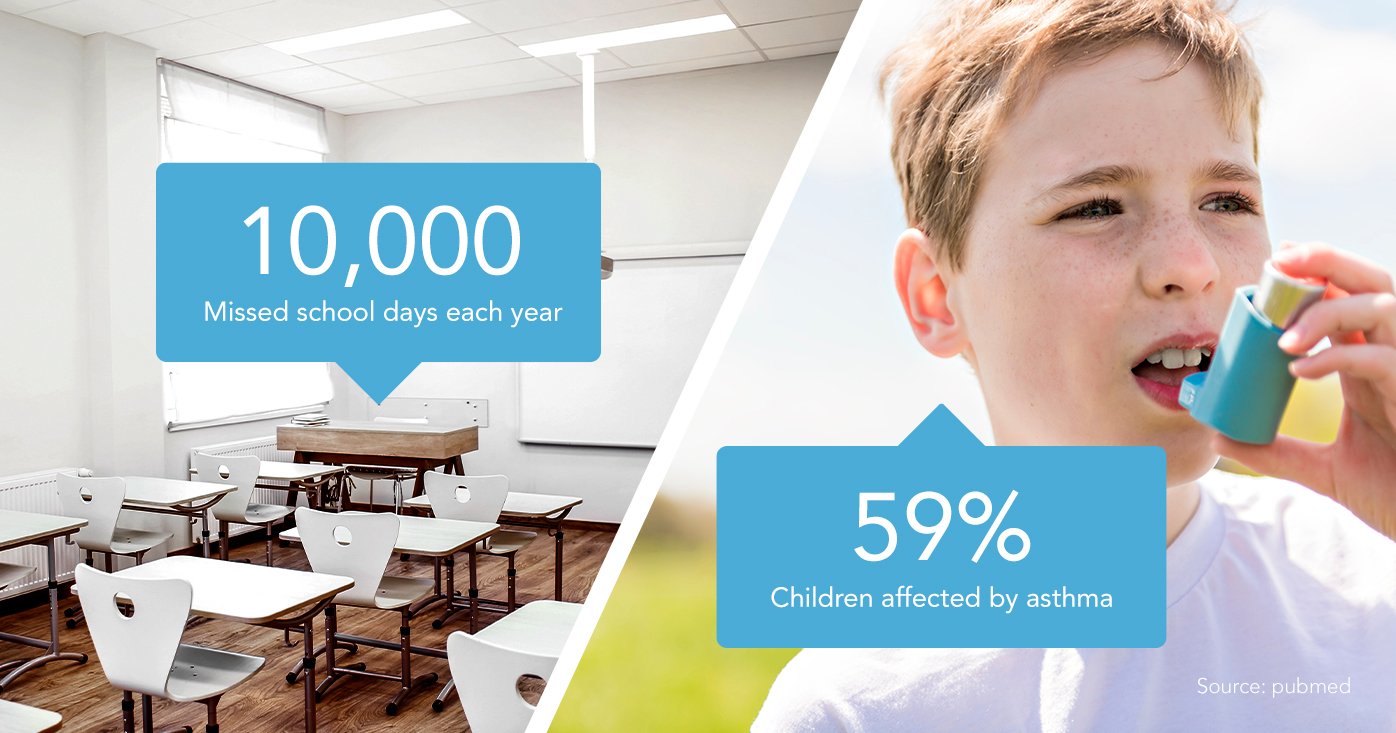
Asthma in education is a growing problem. How can you control the condition and make sure indoor air quality in your educational buildings has a positive effect on the health of students and staff?

Asthma is the most common non-communicable illness affecting children worldwide.[1] That makes it important for schools and colleges, who have a duty of care to protect students and staff members with the condition. The quality of the air we breathe is critical to controlling asthma successfully, because pollutants and allergens in the air we breathe can ‘trigger’ symptoms.
In this article, we’ll examine how asthma affects health, what that means for educational institutions, and how you can provide an optimal learning environment for students and staff by monitoring indoor air quality and addressing any problems.
Asthma is a condition that inflames the airways, or makes them narrower as the muscles contract around them. It causes symptoms like coughing, wheezing or breathlessness that can be aggravated by certain external factors, or ‘triggers’.[2]
Asthma affects an estimated 339 million people worldwide, spanning all ages, but is particularly prevalent among children and young people.[3] In the US, rates of childhood asthma have more than doubled since the 1980s.[4] The UK’s National Health Service (NHS) says it is the most common long-term condition in children and young people,[5] affecting three students in every classroom, on average.[6]
The exact causes of asthma are not known, but it runs in families, particularly when there’s a history of allergies and smoking. In Western countries, the condition often goes alongside other allergies, like eczema and hayfever, and it is linked heavily to pollution, chemicals in the air, and dust.[7]
The condition is so common, particularly in children and young people, that asthma in schools and colleges has become an unavoidable issue. It goes without saying that your educational establishment takes its duty of care to students and staff seriously. For example, staff may already be keeping inhalers on hand for children with asthma. But it’s also important to provide the healthiest possible environment to ease symptoms of asthma in educational buildings.
It’s not just the toll that it takes on health that makes asthma in colleges and other educational institutions so important either.
The condition causes more absenteeism in US schools than any other condition, leading to 10,000 missed school days each year, and affecting 59% of children with asthma.[8] Educationalists believe it contributes to lower rates of attainment, particularly among students from disadvantaged backgrounds.[9]
Regulators worldwide have devoted increasing attention to the impact of indoor air quality on asthma and other allergies in schools. The EU Commission has identified the topic as a key concern,[10] while the Environmental Protection Agency in the US has recommended that schools and colleges adopt its best practices, for a happier, more productive learning environment.[11] 
When people have asthma, their airways are already a little inflamed. However, certain external factors, or triggers, further irritate the lungs and make these symptoms worse.Some common triggers include cigarette smoke, dust mites, damp, and mold, but chemicals that are commonly found in educational buildings can also pose a risk.

Many cleaning products, detergents, disinfectants, solvents, adhesives, paints, polishes, and varnishes contain certain airborne chemicals (VOCs). Asthma symptoms can be triggered or aggravated by breathing in VOCs like formaldehyde, hydrogen peroxide, ethyl alcohol, peroxyacetic acid, sodium hypochlorite, or quaternary ammonium compounds.[12]
In a study of asthma triggers in schools, researchers found significant quantities of problem VOCs in art supplies in 15% of classrooms, cleaning products in 37% of classrooms, and air fresheners, both plug-on and sprays, in 25% of classrooms.[13] In large institutions, it’s particularly difficult to detect whether VOC levels are too high without monitoring, because these odors and gases are present in so many products.
If the humidity in your educational building is too high, it could encourage potential asthma triggers to flourish too. Dust mites thrive where humidity exceeds 50%.[14] Mold and mildew also like to grow in humid environments, where they give off spores that can trigger asthma.[15] Bathrooms, changing rooms, and other environments in educational establishments are common hotspots for mold to proliferate.
In general, many people feel breathing becomes harder work whenever the air is warmer and more humid. This can cause them to breathe faster, which risks making asthma symptoms worse.[16] One study found that teachers with asthma were more likely to experience symptoms when humidity in the classroom exceeded 50%.[17]
High levels of carbon dioxide have been linked to asthma. CO2 builds up in busy classrooms, school halls, or cafeterias and it’s also emitted by engines, heaters, and other outlets likely to exist around a busy school. For people with asthma, the gas has been said to irritate their lungs, effectively lowering their defenses against the condition, while high atmospheric levels encourage greater volumes of pollen and spores, which act as triggers.[18]
 Particulate matter (PM), is another environmental factor that can trigger asthma. PM is a range of particles of dust, dirt, and liquids that are released into the air, often due to human activities such as industry, construction work, landfills, agriculture, and driving of motor vehicles. It’s worth keeping an eye on PM levels in your area, and contacting your local authority if they are continually high, as this air affects the playgrounds or sports fields outside your building. It’s estimated that 9 out of 10 people worldwide breathe polluted air.[19] You can take action to protect the building from outside PM, for example by keeping windows closed at times of high pollution. For some students, staying inside may help to limit asthma symptoms when PM is high.
Particulate matter (PM), is another environmental factor that can trigger asthma. PM is a range of particles of dust, dirt, and liquids that are released into the air, often due to human activities such as industry, construction work, landfills, agriculture, and driving of motor vehicles. It’s worth keeping an eye on PM levels in your area, and contacting your local authority if they are continually high, as this air affects the playgrounds or sports fields outside your building. It’s estimated that 9 out of 10 people worldwide breathe polluted air.[19] You can take action to protect the building from outside PM, for example by keeping windows closed at times of high pollution. For some students, staying inside may help to limit asthma symptoms when PM is high.
The key to better indoor air quality in schools and colleges, and the best conditions to control asthma, is a quality source of information about the air that students and staff breathe. By installing indoor air quality monitors, you access real-time and historical data that will highlight problems, so you can put them right quickly.
The Airthings for Business solution includes powerful monitors that use wireless technology and long-life batteries, so they are quick, painless, and inexpensive to install. All the necessary information is accessed through a user-friendly dashboard that includes insights on how to address any issue with indoor air quality.
The monitors measure key pollutants, like airborne chemicals (VOC s) and carbon dioxide, that trigger asthma symptoms, as well as relevant conditions, like humidity, and temperature. With these tools, you can identify immediately where problems could potentially arise, and take action.
If there are issues with high CO2, for example, there might be a case for improving ventilation, either by utilizing existing systems more effectively, or investing in new equipment. Ventilation is important where VOCs are concerned too, but there are also now many low-VOC and no-VOC products to replace versions that may trigger asthma.
Likewise, the monitors can identify parts of your buildings with particularly high humidity where mold and mildew problems are likely to emerge. These pesky fungi can be combated with better ventilation, anti-mold paints, and dehumidifiers.
In your educational institution, you want to create the best possible environment for students to learn and staff to work, so that you get the best out of everyone. Their wellbeing, health, and happiness is essential for a successful school or college.
By monitoring indoor air quality and focusing on improvements to air quality, you invest in a healthier environment that will help control asthma and other allergies, cut sickness leave, and produce better educational outcomes.

Find out how Airthings for Business can help improve your schools indoor air quality
Talk to us
Sources:
[1] https://www.who.int/news-room/fact-sheets/detail/asthma
[2] https://www.nhlbi.nih.gov/health-topics/asthma
[3] http://www.globalasthmareport.org/Global%20Asthma%20Report%202018.pdf
[4] https://erj.ersjournals.com/content/17/5/881
[5] http://www.youngpeopleshealth.org.uk/wp-content/uploads/2015/09/KeyData2015_Chapter7.pdf
[6] https://www.nwcscnsenate.nhs.uk/files/7914/9666/6429/Final_CYP_LTC_Transition__Report_May_2017.pdf
[7] https://www.asthma.org.uk/advice/understanding-asthma/causes/
[8] https://www.ncbi.nlm.nih.gov/pmc/articles/PMC4914465/
[9] https://pubmed.ncbi.nlm.nih.gov/21923872/
[10] https://ec.europa.eu/health/ph_projects/1999/pollution/efa_en.pdf
[11] https://www.epa.gov/iaq-schools
[12] https://www.cdc.gov/asthma/triggers.html
[13] https://www.ncbi.nlm.nih.gov/pmc/articles/PMC5295350/
[14] https://community.aafa.org/blog/3-ways-humidity-affects-asthma
[15] https://www.cdc.gov/asthma/triggers.html
[16] https://community.aafa.org/blog/3-ways-humidity-affects-asthma
[17] https://cdr.lib.unc.edu/downloads/5999n815h
[18] https://www.webmd.com/asthma/news/20040429/high-carbon-dioxide-levels-may-up-asthma-rate
[19] https://www.who.int/news/item/02-05-2018-9-out-of-10-people-worldwide-breathe-polluted-air-but-more-countries-are-taking-action